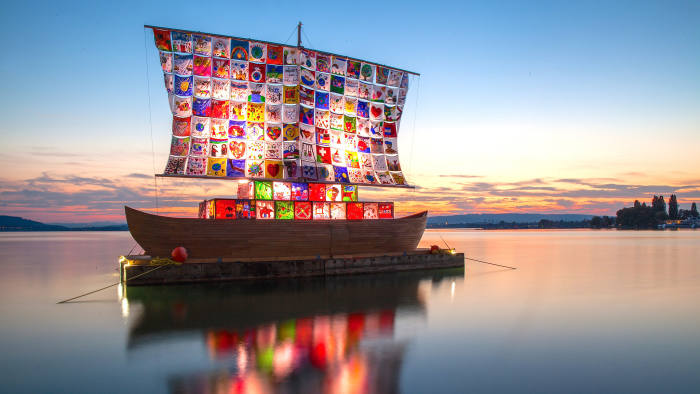
Ship of Tolerance: Sailing towards a better future

The Russian-born Emilia Kabakov’s art project aims to heal geopolitical divisions
The Russian artist Emilia Kabakov watched in horror as a group of teenage boys she had brought together in 2005 in an isolated and fiercely traditional part of western Egypt set on younger children and grabbed the modest gifts they had just been given. She remembered a saying from the Caucasus, learnt during her upbringing in the USSR. “If a woman stands between two men who are fighting, they cannot continue,” recalls the diminutive but fearless artist. “So I went in and stopped them.”
The stand-off was a turning point in a project aimed at linking the local community to an international art-loving elite. It has evolved into “The Ship of Tolerance”, an ambitious, expanding series of events around the world to bring together divided communities through children, using art and music.
The project has run nearly a dozen times over the past decade; recently opened in Rostock, Germany, it is set to visit London and Chicago in 2019. In its appeal to children and its themes of legacy, it is of a piece with the playful oeuvre of Emilia and her husband Ilya, the Soviet-born, US-resident installation artists who had a retrospective at London’s Tate Modern last year. But it has also taken on a life of its own over the years, with much of the creative effort coming from participants in the divided communities that host it.
The idea came when Emilia was invited to Siwa, a remote district on the border of Libya, in 2005, where the owner of a local hotel and other patrons backed a series of projects with world-renowned artists. She spent time in the local village school, in which boys were segregated from girls, many of whom would be married at 12 years old. Not far away was a stunning shallow salt lake in an oasis that most of the pupils had never visited.
“It was a beautiful lake in the middle of nowhere, and had never been used by ships, so we decided to build one,” Kabakov says. “It was a very mysterious place. For the first time I was really working by myself, although I developed it together with Ilya.”
She worked with the local school teacher to get the students to make paintings of a ship — an object they had never seen — which would form the sails. To construct the “Ship of Siwa” itself, she turned to David Harold, a joinery and carpentry lecturer at Manchester College of Arts and Technology with whom she had worked previously.
He in turn selected half a dozen teenage students from the UK, who travelled to the oasis to build the ship from local bamboo and reeds. “Some of them had never been out of the country,” he recalls. “I didn’t choose the best carpenters. I chose the ones I thought needed to go, to see different cultures. It’s something they will never forget.”
The teenage Mancunians struggled to communicate, and it was the modest gifts of pencils and stickers they offered to local children that sparked the fighting. But with time, and through games, they forged links.
Two years later, Kabakov took the Ship of Tolerance to the Venice Biennale, where she worked with troubled schools with large immigrant intakes to produce the sails, with the theme of tolerance. “It’s interesting to talk to small children, who are not intimidated,” she says. A Haitian girl said how important it was to intermarry, so no one had a different skin colour. A boy talked about giving parents the chance not to fight. “You immediately saw their particular problems,” Kabakov says.
After Italy, she tried “a crazy idea”: to take the Ship from Miami to Havana, to ease the tense relations between Cubans and exiles in the US. But the Florida-based émigrés fiercely criticised the project, putting pressure on the original backers to withdraw support. “It was a disaster. I had so many hateful calls. I used logic, they screamed,” she shrugs.
With a new backer, the Miami ship was built, but soon dismantled after just a few showings. She had more success on the second leg in Cuba, where the Castro regime authorised the project. Kabakov recruited her daughter Viola and they organised an event bringing together Cuban children with their counterparts from the US and Russia for a dance performance and concert. Only after lengthy calls to the US State Department did Viola get authorisation for the American children to attend.
Emilia recalls one painting from a Cuban schoolchild for the ship’s sails showing a fruit-filled plate with a fly hovering above and a spider looming over both, and asked him how that symbolised tolerance.“The fly wants to eat the fruit, and the spider the fly, but they don’t,” he replied. “That’s tolerance.”
New Ships and projects around them have also taken place in Sharjah, Russia, the Vatican, Switzerland and New York. Kabakov is currently working to finalise funding to bring the Ship to London, as well as Washington, DC, places where she believes the Brexit referendum and Donald Trump’s presidency have added fresh urgency to the project’s aims.
“At some point I will quit, and let our kids continue,” she says, as she prepares a new online project to divert young people from the lure of intolerance. “The situation is getting worse, there is so much hate in the world. Are we going back to the caves?”

In Rostock, Germany © Daniel Hegglin